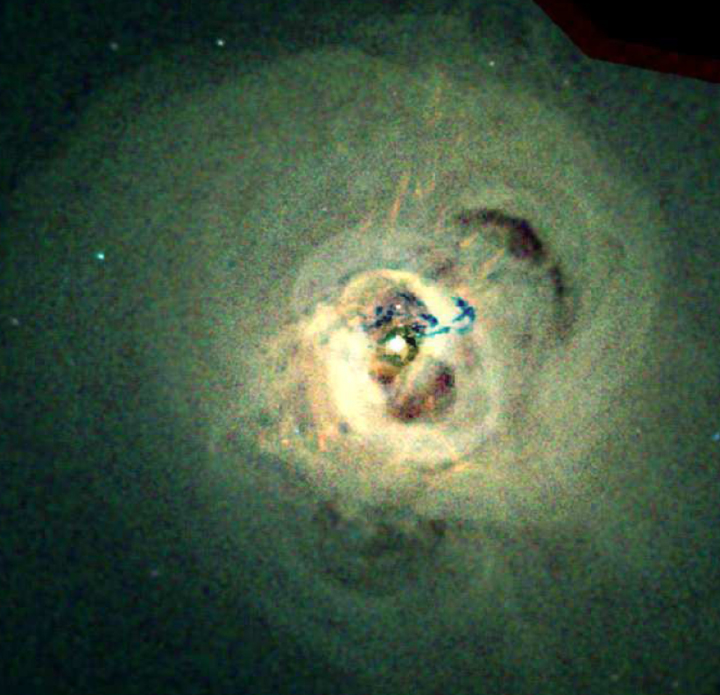Figure 6. Channel maps for the main body (upper set of panels) and secondary body (lower set of panels). The heliocentric velocity of each channel is indicated. Notice the similar overall morphology of the main and secondary bodies in each panel separated by 120 km s−1. The cross in each panel marks the approximate geometrical center of the main body of the HVS. The white rectangle in the lower set of panels corresponds to the region where an outflow associated with the AGN in NGC 1275 is detected; this outflow produces a relatively strong and very broad component in the red wing of the [N ii]λ6583 Å line from NGC 1275, thus obscuring any line emission associated with the secondary body of the HVS. The angular resolution of the maps is 2
2017/01/22
The High-velocity System: Infall of a Giant Low-surface-brightness Galaxy toward the Center of the Perseus Cluster
http://adsabs.harvard.edu/abs/2015ApJ...814..101Y
Figure 6. Channel maps for the main body (upper set of panels) and secondary body (lower set of panels). The heliocentric velocity of each channel is indicated. Notice the similar overall morphology of the main and secondary bodies in each panel separated by 120 km s−1. The cross in each panel marks the approximate geometrical center of the main body of the HVS. The white rectangle in the lower set of panels corresponds to the region where an outflow associated with the AGN in NGC 1275 is detected; this outflow produces a relatively strong and very broad component in the red wing of the [N ii]λ6583 Å line from NGC 1275, thus obscuring any line emission associated with the secondary body of the HVS. The angular resolution of the maps is 2 7 at FWHM.
7 at FWHM.
Figure 6. Channel maps for the main body (upper set of panels) and secondary body (lower set of panels). The heliocentric velocity of each channel is indicated. Notice the similar overall morphology of the main and secondary bodies in each panel separated by 120 km s−1. The cross in each panel marks the approximate geometrical center of the main body of the HVS. The white rectangle in the lower set of panels corresponds to the region where an outflow associated with the AGN in NGC 1275 is detected; this outflow produces a relatively strong and very broad component in the red wing of the [N ii]λ6583 Å line from NGC 1275, thus obscuring any line emission associated with the secondary body of the HVS. The angular resolution of the maps is 2
ラベル:
perseis:HVS,
perseus
A very deep Chandra observation of the Perseus cluster: shocks, ripples and conduction
http://adsabs.harvard.edu/abs/2006MNRAS.366..417F
http://chandra.harvard.edu/photo/2005/perseus/
http://chandra.harvard.edu/photo/2005/perseus/
Fig.3 Colour image made from the 0.3–1.2 (red), 1.2–2 (green) and 2–7 keV (blue) bands. A 10-arcsec smoothed image has been scaled to 80 per cent of its intensity and then subtracted in order to bring out fainter features lost in the high-intensity range of raw images. The blue structure to the N of the nucleus is caused by absorption in the infalling high-velocity system, We suspect that these arc-like pressure minima are old bubbles. projected at least 60 kpc in front of the nucleus of NGC 1275 (Gillmon, The large size of these bubbles could indicate that the activity was Sanders & Fabian 2004).
ラベル:
Chandra,
fabian,
perseis:HVS,
perseus
On the Nature of the NGC 1275 System
http://adsabs.harvard.edu/abs/2001AJ....122.2281C
http://iopscience.iop.org/article/10.1086/323534/fulltext/
from Introduction
NGC 1275 (Perseus A, 3C 84) is one of the most unusual early-type galaxies in the nearby universe and contains an example ofalmost every known extragalactic phenomenon. However, several of its basic observed features still remain a mystery. NGC 1275 is located at the center of the Perseus Cluster and resembles a normal elliptical galaxy on low-resolution plates (Hubble & Humason 1931). Humason (1932) and later Seyfert (1943) discovered strong emission lines in NGC 1275. Later, Minkowski (1955) found twodistinct emission-line systems toward NGC 1275: a high-velocity (HV) component at V = 8200 km s-1 and a low-velocity (LV) one at V = 5200 km s-1. The stellar radial velocity of NGC 1275 is 5264 ± 11 km s-1 (Huchra, Vogeley, & Geller 1999), while the velocitydispersion of the Perseus Cluster is 1277 km s-1 (Struble & Rood 1991). The puzzling nature of NGC 1275 was compounded by thediscovery of an extensive array of emission-line filaments projecting away from the central galaxy (Minkowski 1957; Lynds 1970). The origin of these features is still being debated (see, e.g., McNamara, O'Connell, & Sarazin 1996; Sabra, Shields, & Filippenko 2000).
http://iopscience.iop.org/article/10.1086/323534/fulltext/
from Introduction
NGC 1275 (Perseus A, 3C 84) is one of the most unusual early-type galaxies in the nearby universe and contains an example ofalmost every known extragalactic phenomenon. However, several of its basic observed features still remain a mystery. NGC 1275 is located at the center of the Perseus Cluster and resembles a normal elliptical galaxy on low-resolution plates (Hubble & Humason 1931). Humason (1932) and later Seyfert (1943) discovered strong emission lines in NGC 1275. Later, Minkowski (1955) found twodistinct emission-line systems toward NGC 1275: a high-velocity (HV) component at V = 8200 km s-1 and a low-velocity (LV) one at V = 5200 km s-1. The stellar radial velocity of NGC 1275 is 5264 ± 11 km s-1 (Huchra, Vogeley, & Geller 1999), while the velocitydispersion of the Perseus Cluster is 1277 km s-1 (Struble & Rood 1991). The puzzling nature of NGC 1275 was compounded by thediscovery of an extensive array of emission-line filaments projecting away from the central galaxy (Minkowski 1957; Lynds 1970). The origin of these features is still being debated (see, e.g., McNamara, O'Connell, & Sarazin 1996; Sabra, Shields, & Filippenko 2000).
ラベル:
perseis:HVS,
perseus
登録:
投稿 (Atom)

